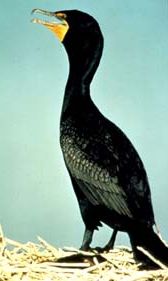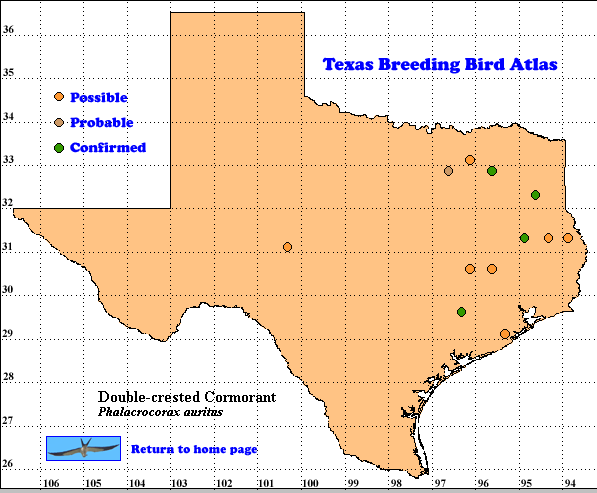In Texas, the Double-crested Cormorant is primarily a wintering species with peak numbers (50,000-90,000) occurring October through March along the coast and inland, mainly associated with large reservoirs, mostly in the eastern two-thirds of the state (east of the 100th meridian). Primary origins of Texas band recoveries are: Alberta, Saskatchewan, Manitoba, North Dakota, South Dakota, Montana, and Minnesota; there are no recoveries of birds banded west of the Rocky Mountains or in the eastern United States or Canada (Thompson et al. 1995). Populations of Double-crested Cormorants were reduced throughout North America in the early 1900s, but their numbers have increased phenomenally since 1970 attributed to decline in contamination by chlorinated hydrocarbons (especially DDT), reduction in human persecution via protective laws, increased food availability in breeding and wintering areas associated with the creation of artificial water impoundments, increased breeding habitat via dead standing trees in reservoirs, and associated improved breeding success (Hatch and Weseloh 1999, Wires et al. 2001).
Breeding records of the Double-crested Cormorant in Texas are both interesting and curious. The earliest documented record is coastal in 1926 on Matagorda Peninsula (Upper Coast Region); other records in the late 1930s document the species as a rare and local breeder far inland in the northwest North Central Region (Baylor and Wilbarger counties); then, breeding appears to have ceased for more than 30 years, with the last nesting record (1939) obtained in Wilbarger County (Oberholser 1974). Nesting was not documented again until 1974 and 1977 on Toledo Bend Reservoir–eastern Lower East Texas Region (Holm et al. 1978, Mitchell 1978, Morrison 1979). Since the late 1980s small breeding colonies (≤ 50 nests per site, n = 28, range = 1-50, mean = 15 ± 15 SD, median = 12.5) have been reported in scattered locations: eastern regions–Lower East Texas Region (Sabine, San Augustine, and Trinity counties), Upper East Texas Region (Delta and Wood Counties), north central region (Knox County), and western regions–Upper and Lower Panhandle Region (Hansford and Randall Counties), northwestern Edwards Plateau Region (Midland County), and western and central Trans-Pecos Region (Hudspeth and Reeves Counties, respectively), and Upper Texas Coast in Colorado County (Dabbert and Wrinkle 2001; Amer. Birds, Field Notes, N. Amer. Birds, Northeast Texas Field Ornithologists, Texas Colonial Waterbird Censuses, Dan Boone, David Brotherton, Mike Dillon, Bill Howe, Don Merritt, Peat Robinson, Ken Seyffert, David Weaver, Matt White, Frances Williams, in litt./pers. comm..).
Two reports of breeding records (Texas. Ornithol. Soc. 1995, Wires et al. 2001) are in error–in 1973 for Midland County (northwest Edwards Plateau Region) and in 1990 for Harrison County (Upper East Texas Region). The 1973 error was a mistype (should be 1993) and the 1990 error involved 8 adults and one juvenile or immature bird seen, but no nest record (B. Howe and Guy Luneau, pers.comm., respectively). Some of these nestings are recent, but others are re- colonizations.
DISTRIBUTION: Better documentation of nesting records is necessary to accurately describe the distribution of breeding Double-crested Cormorants in Texas. Unfortunately, the species can be confused with the Neotropic Cormorant (P. brasilianus), a species that is also expanding its breeding range within Texas and the two species can nest at the same site. At this time, the distribution can only be described as small local colonies scattered throughout the eastern, north central, Panhandle, northwest Edwards Plateau, and Trans-Pecos regions of Texas with no apparent pattern. Confirmed years, breeding locations, and number of nests (xn) are: 1926 (Matagorda Peninsula and nearby island, near Brown Cedar Cut, Matagorda County “a number of nests”), 1937 (upper end of Lake Kemp, Baylor County, 1n), 1938-1939 (Santa Rosa Lake, Wilbarger County, 20n, “many nests”), 1974 (extreme southern end of Toledo Bend Reservoir at the mouth of Mill Creek Bay, Sabine County,17n), 1977 (Toledo Bend Reservoir, mid-reservoir at Texas highway 21 bridge, Sabine County, 1n), 1987 (Eagle Lake, Colorado County, 20n), 1990 (Boggy Slough North, Trinity County, 6n), 1991 (Toledo Bend Reservoir at Six Mile Creek, Sabine County Lake Fork Reservoir, Wood County, 18n), 1992 (Cooper Lake, Delta County 1n; Toyah Lake, Reeves County, 3n), 1993 (flooded playa adjacent to Consavvy Lake, Midland County, 5n), 1994 (Palo Duro Reservoir, Hansford County, no count given; McNary Reservoir, Hudspeth County, no count given), 1995 (Palo Duro Reservoir, Hansford County, 12n; McNary Reservoir, Hudspeth County, 50n); 1996 (Palo Duro Reservoir, Hansford County, 15n; Ft. Hancock, Hudspeth County, 10n; McNary Reservoir, Hudspeth County, 20n), 1997 (Palo Duro Reservoir, Hansford County, 13n; McNary Reservoir, Hudspeth County, 50n ; Truscott Brine Lake, Knox County, 6n), 1998 (Palo Duro Reservoir, Hansford County, no count given; Truscott Brine Lake, Knox County, 11n), 1999-2000 (Palo Duro Reservoir, Hansford County, 15n, 21n; McNary Reservoir, Hudspeth County 50n, no information; Buffalo Lake, Randall County, 2n, 13n), 2001-2002 (Palo Duro Reservoir, Hansford County “small number”, no count given; Buffalo Lake, Randall County, “few”, 3n; Sam Rayburn Reservoir, San Augustine County, 4n, no count given), 2003 (Palo Duro Reservoir, Hansford County, 39n), and 2005 (Buffalo Lake, Randall County, 6n).
SEASONAL OCCURRENCE: For Texas migrants, the earliest arrival is August 6, peak migrant populations occur between October and January; with the latest date being June 23 (Thompson et al. 1995). Texas breeding records indicate eggs and young present from May 20 to July 10 (Oberholser 1974). with scattered summer records.
BREEDING HABITAT: In reservoirs Double-crested Cormorants nest in live or dead trees standing in water. An unusual nest site was on an inoperable oil field pumpjack in a playa lake in Midland County. They may nest as single pairs, in small single species colonies, or associated with other colonial waterbirds. There are no nest descriptions for Texas; but, in general, nests are about 61 cm (2 feet) in diameter. Tree nests are usually much smaller than ground nests but have deeper inner cavities; arboreal nests are 0.5-30 m (1.6-98 feet) above ground in forks of branches or adjacent to trunks. Double-crested Cormorants may usurp attended or unoccupied nests of Great Blue Herons (Ardea herodias) and Great Egrets (A. alba). Nest materials include finger-sized sticks and a wide variety of diverse flotsam and jetsom, parts of dead birds, with lining of grass and rootlets. Nest materials may be cemented together with guano. This cormorant species exhibits strong fidelity to colony sites and nests may be reused (Hatch and Weseloh 1999).
STATUS: The origin of breeding Double- crested Cormorants in Texas is unclear (Palmer 1962, Johnsgard 1993, Wires et al. 2001). Western birds may be sedentary individuals of the migratory interior population zone (P. a. auritus) as revealed by band recoveries (Thompson et al. 1995); eastern birds may be year-round residents within the recently expanding southern United States population zone (P. a. floridanus). At this time, breeding population trends in Texas cannot be described since systematic surveys have not been conducted and very limited information is available about current numbers and distribution (J. Herron, pers. comm., Wires et al. 2001.)
Text by Raymond C. Telfair II (2006).
Literature cited.
Dabbert, C. B. and L. Wrinkle. 2001. Bird survey report: avian community dynamics at Truscott Brine Lake. Appendix A in Selenium monitoring results: Truscott Brine Lake, TX and associated brine collection areas, 1997-1998. Envir. Anal. and Compl. Branch, USACOE, Tulsa Dist., OK.
Hatch, J. J., and D. V. Weseloh. 1999. Double-crested Cormorant (Phalacrocorax auritus). In The Birds of North America, No. 441 (Poole and F. Gill, eds.). The Birds of North America, Inc., Philadelphia, PA.
Holm, S. F., H. D. Irby, and J. M. Inglis. 1978. First nesting record of Double-crested Cormorant in Texas since 1939. Bull. Texas Ornithol. Soc. 11: 50-51.
Johnsgard, P. A. 1993. Cormorants, darters, and pelicans of the world. Smithsonian Institution Press, Washington, D.C.
Mitchell, R. M. 1978. Status of the Double-crested Cormorant in Utah as related to Texas Cormorants. Pp. 6-16 in Proc. 4th Annual Texas Fish-eating Bird Conf., Texas Parks and Wildl. Dept. Rep. 7000-26, Austin.
Morrison, M. L. 1979. The cormorants of Texas. Bull. Texas Ornithol. Soc. 12: 35-36.
Oberholser, H. C. 1974. The bird life of Texas. Univ. Texas Press, Austin.
Palmer, R. S., ed. 1962. Handbook of North American birds, Vol. 1. Yale Univ. Press, New Haven, CT.
Texas Ornithological Society. 1995. Checklist of the birds of Texas, 3rd ed. Printed by Capital Printing, Inc., Austin, TX.
Thompson, B. C., J. J. Campo, and R. C. Telfair II. 1995. Origin, population attributes, and management conflict resolution for Double-crested Cormorants wintering in Texas. Pp. 181-188 in Nettleship, D. N. and D. C. Duffy. eds. The Double-crested Cormorant; biology, conservation and management. Colonial Waterbirds 18 (special publ. 1).
Wires, L. R., F. J. Cuthbert, D. R. Trexel, and A. R. Joshi. 2001. Status of the Double-crested Cormorant (Pharacrocorax auritus) in North America. USFWS Rep.

